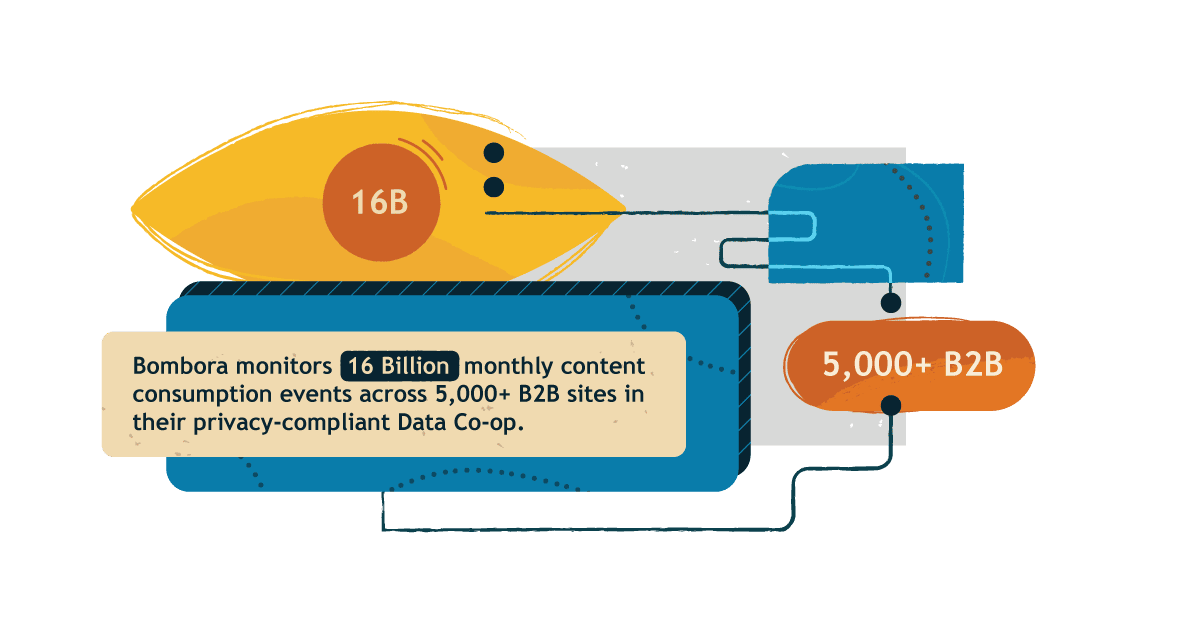Only 15% of your buyers are in-market at any time – how does Intent data find them?
Someone just downloaded an eBook!
Time to fire up the ol’ lead nurturing campaign, right?
Yeah…maybe not.
Bombora’s Intent data shows that 15% of buyers are actually in-market at any given time.
Since the average professional already spends almost 30% of their workday reading and answering email already, nothing is a bigger customer turn-off than getting bombarded with emails from a business just because you clicked a link, watched a single webinar, or downloaded one eBook – especially if you’re in the 85% who aren’t currently in an active buying stage.
…but that’s what your lead scoring process is for right?
Is your MQL really an MQL?
No doubt about it, a well-thought-out lead scoring program is a great tool to help increase your sales and marketing efficiency and boost your conversion rate.
Proper lead scoring ensures you’re focusing your limited resources most effectively on the prospects who have the right demographic and firmographic data to align with your ideal customer profile (ICP) and who’ve taken enough relevant actions to show that they’re actually looking for a solution.
…but this doesn’t always tell the full story.
In fact, it’s usually missing one key element: The noise floor.
Is this true Intent, or just noise?
Question: How loud is it when you drop a fork?
Answer: It depends.
If you’re sneaking around for a midnight snack, a salad fork hitting the floor sounds more like a sonic boom than a small cutlery concussion, but, if you’re standing on the tarmac next to a Boeing 747 during take-off, you wouldn’t even hear it if you dropped a sledgehammer.
What’s the difference?
The noise floor.
The noise floor is just a baseline – How much noise is around me already? – and it helps determine the relative intensity of the other sounds we experience.
Similarly to our salad fork fiasco, we need to assess our prospects’ consumption events relative to their baseline level of activity to understand if the intensity of these events is significant or not.
Since people at your target accounts are always consuming information, we shouldn’t just look at isolated events, like reading an article or downloading an eBook. While it may indicate your content is part of their online research journey, it doesn’t necessarily indicate heightened levels of interest or intent to buy.
To notice a truly meaningful change in an account’s research or activity intensity, we need to measure their activity over time. This way we can separate a significant change from their typical levels of activity.
In other words, it’s not just the events that count, it’s the frequency, duration, and intensity in which they occur that matter.
Cut through the noise with Company Surge®
Measuring an individual against his or her baseline activity is hard, but measuring this data across an entire account is much harder.
…and, while benchmarking against your first-party data can get you a headstart, to really get a full picture of an account’s baseline activity, you need to incorporate insights from high-quality third-party data as well – Accounts are always active, but they’re not always active on your site.
Here’s a peek under the hood at how we do it with Company Surge®:
- Group individual IP addresses to their appropriate domain/business
Knowing an individual’s level of interest is certainly important, but with today’s B2B sale involving 6 to 10 decision-makers, you need to look for broader trends from a business to understand if they’re really ready to buy.
That’s where Company Surge® really changes the game for your ABM campaigns. Grouping all of the individual IP addresses and associating them with the target accounts on your list, you’ll know which accounts are active and interested.
- Classify consumption events into topics and themes
At Bombora, we know that activity without purpose is just noise, so we don’t just passively monitor the 16 Billion monthly content consumption events across the 5,000+ B2B sites in our Data Co-op – We use our deep-learning algorithms to auto-classify all of these actions into 10,000+ easily searchable topics across 12 themes.
The sheer amount of activity captured on our platform (approximately 1 Billion consumption events per day) can be overwhelming, so we filter this activity down so you only receive the data that’s applicable to you.
- Measure activity intensity vs. a baseline for each account
With Company Surge®, you don’t just get a list of prospect activity – you get an easy-to-use Intent score (a score that’s calculated with each account’s baseline included).
So, for example, a score of 50 (average) doesn’t mean that there’s no research happening at an account, it just means that the amount of research isn’t intense enough to be considered a significant change. It doesn’t significantly exceed the noise floor.
When a business is looking to make a large purchase, research activity doesn’t just increase – it spikes. Company Surge® detects this sudden and rapid increase of activity, which is reflected in a Topic Surge Score of 60+.
The results?
Bombora’s Intent data has shown that, while virtually every healthy business shows activity of some kind every month, only 15% of buyers are in-market at a given time.
This means that 85% of accounts that are showing activity aren’t significantly exceeding their baselines or actually in-market. These accounts are just going through their standard motions, and over-targeting them or serving them too much content (or content that doesn’t line up with their current stage in the buying journey) could potentially burn them out and waste your precious sales resources.
So, how will you know if that eBook download means something?
Don’t worry, we’ll tell you.




